View in other NatureServe Network Field Guides
NatureServe
Montana
Utah
Wyoming
Idaho
Wisconsin
British Columbia
South Carolina
Yukon
California
New York
Pink-edged Sulphur - Colias interior
Native Species
Global Rank:
G5
State Rank:
S5
Agency Status
USFWS:
USFS:
BLM:
External Links
General Description
[From Ferris and Brown 1981; Scott 1986; Opler and Wright 1999; Glassberg 2001; Pyle 2002] Forewing 2.3-2.6 cm. Prominent bright pink wing fringes, wings noticeably rounded, base color bright yellow in males, light yellow to whitish in females. Uppersurface with small black forewing cell spot and orange hindwing cell spot, male forewing with black border curved and narrow (wider at wingtip), extending to hindwing; females with reduced black border, hindwing without black. Undersurface of forewing with open cell end-bar, hindwing yellow with single round pearly cell spot heavily rimmed in dark pink, post-median spots absent.
Phenology
One flight, mostly mid-June to mid-August, mid-July to mid-August in Newfoundland and Saskatchewan (Scott 1986). Mainly late Jun to August (Glassberg 2001). June to August in the Rocky Mountain states (Ferris and Brown 1981), early June to mid-September in Oregon and Washington (Pyle 2002), mid-June to late August in Oregon (Warren 2005), June and July in British Columbia (Guppy and Shepard 2001).
Diagnostic Characteristics
Best determined by combination of bright pink wing fringes, wings noticeably rounded, forewing with black border curved and narrow (wider at wingtip), hindwing yellow with single round pearly cell spot heavily rimmed in dark pink, post-median spots absent.
Species Range
Montana Range
Range Descriptions
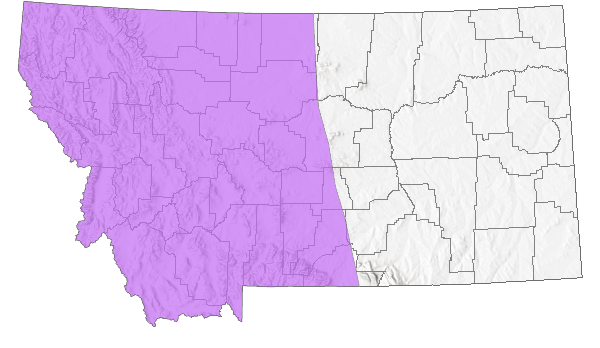
 Native
Native
Range Comments
British Columbia to central Oregon, east through northern Idaho, western Montana, boreal Canada and Great Lakes region to Maritime Provinces and northern New England; isolated populations in central Appalachians (Scott 1986; Ferris 1988; Opler and Wright 1999; Glassberg 2001); 792 m to at least 2134 m elevation in Oregon (Pyle 2002; Warren 2005). In Montana, reported from at least 21 counties in the western 1/3 of the state (Kohler 1980; Ferris 1988; Stanford and Opler 1993; FLMNH Lepidopterists' Society database), to at least 2212 m elevation. Uncommon to common (Glassberg 2001).
Observations in Montana Natural Heritage Program Database
Number of Observations: 13
(Click on the following maps and charts to see full sized version)
Map Help and Descriptions
Relative Density
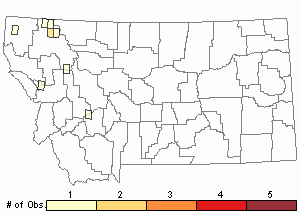
Recency
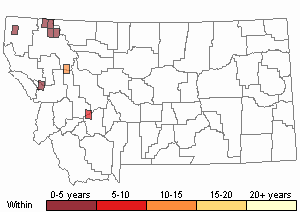
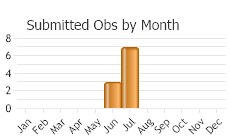
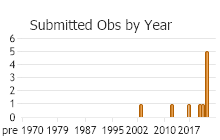
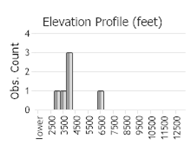 (Observations spanning multiple months or years are excluded from time charts)
(Observations spanning multiple months or years are excluded from time charts)
Migration
Non-migratory.
Habitat
Boggy areas, Vaccinium-rich mesic montane meadows, power line cuts, roadsides, logged and burned sites (Ferris and Brown 1981; Ferris 1988; Opler and Wright 1999; Glassberg 2001; Pyle 2002). In Glacier National Park, Montana reported from mesic montane meadows (Debinski 1993); in Greater Yellowstone Ecosystem reported from burned-over brush land with Vaccinium and willow-sedge meadows (Debinski and Pritchard 2002; Debinski et al. 2013).
Food Habits
Larval food plants included several species of Vaccinium (Ferris and Brown 1981; Scott 1986; Ferris 1988; Guppy and Shepard 2001; Pyle 2002; Warren 2005). Adults feed on flower nectar (including Lotus, Prunella, Senecio, Taraxacum, Trifolium, other meadow composites) and mud (Scott 1986; Ferris 1988; Pyle 2002; James and Nunnallee 2011).
Reproductive Characteristics
Females lay eggs singly, usually on upper surface of host plant leaves. Eggs hatch in about 4 days (depending on temperature), develop from L1 instar to L3 instar and enter dormancy (hibernate) in about 11-15 days (Ae 1958; James and Nunnallee 2011). After exiting dormancy L3 instar develop to L5 instar and pupae in about 31 days, adults eclose (emerge from pupae) in 6-17 days, depending on temperature (Ae 1958; James and Nunnallee 2011); some larvae return to dormancy suggesting possible 2-year life cycle by some individuals. Young larvae skeletonize leaves as they feed, overwinter as L3 instar (L1 and L2 instar reported), older larvae cannibalistic in captivity, larvae rest on upper surface of leaf on midrib, pupate on host plant twigs (Scott 1979, 1986; Guppy and Shepard 2001; James and Nunnallee 2011). Males patrol slowly over large areas in openings in search of females (Scott 1986; Ferris 1988; Pyle 2002; James and Nunnallee 2011).
Stewardship Responsibility
References
- Literature Cited AboveLegend:
 View Online Publication
View Online Publication Ae, S.A. 1958. Comparative studies of developmental rates, hibernation, and food plants in North American Colias (Lepidoptera, Pieridae). American Midland Naturalist 60: 84-96.
Ae, S.A. 1958. Comparative studies of developmental rates, hibernation, and food plants in North American Colias (Lepidoptera, Pieridae). American Midland Naturalist 60: 84-96. Debinski, D. 1993. Butterflies of Glacier National Park, Montana. Occasional Papers of the Museum of Natural History, the University of Kansas, Lawrence, Kansas. No. 159: 1-13.
Debinski, D. 1993. Butterflies of Glacier National Park, Montana. Occasional Papers of the Museum of Natural History, the University of Kansas, Lawrence, Kansas. No. 159: 1-13. Debinski, D.M. and J.A. Pritchard. 2002. A field guide to the butterflies of the Greater Yellowstone Ecosystem. Lanham, MD: Roberts Rinehart Publishers. 107 p.
Debinski, D.M. and J.A. Pritchard. 2002. A field guide to the butterflies of the Greater Yellowstone Ecosystem. Lanham, MD: Roberts Rinehart Publishers. 107 p. Debinski, D.M., J.C. Caruthers, D. Cook, J. Crowley, and H. Wickham. 2013. Gradient-based habitat affinities predict species vulnerability to drought. Ecology 94(5): 1036-1045.
Debinski, D.M., J.C. Caruthers, D. Cook, J. Crowley, and H. Wickham. 2013. Gradient-based habitat affinities predict species vulnerability to drought. Ecology 94(5): 1036-1045. Ferris, C.D. 1988. Revision of the North American Ericaciae-feeding Colias species, (Pieridae, Coliadinae). Bulletin of the Allyn Museum 122: 1-34.
Ferris, C.D. 1988. Revision of the North American Ericaciae-feeding Colias species, (Pieridae, Coliadinae). Bulletin of the Allyn Museum 122: 1-34. Ferris, C.D. and F.M. Brown (eds). 1981. Butterflies of the Rocky Mountains. Univ. of Oklahoma Press. Norman. 442 pp.
Ferris, C.D. and F.M. Brown (eds). 1981. Butterflies of the Rocky Mountains. Univ. of Oklahoma Press. Norman. 442 pp. Glassberg, J. 2001. Butterflies through Binoculars: A Field Guide to the Butterflies of Western North America. Oxford University Press.
Glassberg, J. 2001. Butterflies through Binoculars: A Field Guide to the Butterflies of Western North America. Oxford University Press. Guppy, C.S. and J.H. Shepard. 2001. Butterflies of British Columbia: including western Alberta, southern Yukon, the Alaska Panhandle, Washington, northern Oregon, northern Idaho, northwestern Montana. UBC Press (Vancouver, BC) and Royal British Columbia Museum (Victoria, BC). 414 pp.
Guppy, C.S. and J.H. Shepard. 2001. Butterflies of British Columbia: including western Alberta, southern Yukon, the Alaska Panhandle, Washington, northern Oregon, northern Idaho, northwestern Montana. UBC Press (Vancouver, BC) and Royal British Columbia Museum (Victoria, BC). 414 pp. James, D.G. and D. Nunnallee. 2011. Life histories of Cascadia butterflies. Corvallis, OR: Oregon State University Press. 447 p.
James, D.G. and D. Nunnallee. 2011. Life histories of Cascadia butterflies. Corvallis, OR: Oregon State University Press. 447 p. Kohler, S. 1980. Checklist of Montana Butterflies (Rhopalocera). Journal of the Lepidopterists' Society 34(1): 1-19.
Kohler, S. 1980. Checklist of Montana Butterflies (Rhopalocera). Journal of the Lepidopterists' Society 34(1): 1-19. Opler, P.A. and A.B. Wright. 1999. A field guide to western butterflies. Second edition. Peterson Field Guides. Houghton Mifflin Company, Boston, Massachusetts. 540 pp.
Opler, P.A. and A.B. Wright. 1999. A field guide to western butterflies. Second edition. Peterson Field Guides. Houghton Mifflin Company, Boston, Massachusetts. 540 pp. Pyle, R.M. 2002. The butterflies of Cascadia: a field guide to all the species of Washington, Oregon, and surrounding territories. Seattle Audubon Society, Seattle, Washington. 420 pp.
Pyle, R.M. 2002. The butterflies of Cascadia: a field guide to all the species of Washington, Oregon, and surrounding territories. Seattle Audubon Society, Seattle, Washington. 420 pp. Scott, J.A. 1979. Hibernal diapause of North American Papilionoidea and Hesperioidea. Journal of Research on the Lepidoptera 18(3): 171-200.
Scott, J.A. 1979. Hibernal diapause of North American Papilionoidea and Hesperioidea. Journal of Research on the Lepidoptera 18(3): 171-200. Scott, J.A. 1986. The butterflies of North America: a natural history and field guide. Stanford University Press, Stanford, California.
Scott, J.A. 1986. The butterflies of North America: a natural history and field guide. Stanford University Press, Stanford, California. Stanford, R.E. and P.A. Opler. 1993. Atlas of western USA butterflies: including adjacent parts of Canada and Mexico. Unpubl. Report. Denver and Fort Collins, Colorado 275 pp.
Stanford, R.E. and P.A. Opler. 1993. Atlas of western USA butterflies: including adjacent parts of Canada and Mexico. Unpubl. Report. Denver and Fort Collins, Colorado 275 pp. Warren, A.D. 2005. Lepidoptera of North America 6: Butterflies of Oregon, their taxonomy, distribution, and biology. Contributions of the C. P. Gillette Museum of Arthropod Diversity, Colorado State University. Fort Collins, Colorado. 406 pp.
Warren, A.D. 2005. Lepidoptera of North America 6: Butterflies of Oregon, their taxonomy, distribution, and biology. Contributions of the C. P. Gillette Museum of Arthropod Diversity, Colorado State University. Fort Collins, Colorado. 406 pp.
- Additional ReferencesLegend:
 View Online Publication
View Online Publication
Do you know of a citation we're missing? Allen, T.J., J.P. Brock, and J. Glassberg. 2005. Caterpillars in the field and garden: a field guide to the butterfly caterpillars of North America. Oxford University Press.
Allen, T.J., J.P. Brock, and J. Glassberg. 2005. Caterpillars in the field and garden: a field guide to the butterfly caterpillars of North America. Oxford University Press. Brock, J.P. and K. Kaufman. 2003. Kaufman Field Guide to Butterflies of North America. Houghton Mifflin Company, New York, NY 284 pp.
Brock, J.P. and K. Kaufman. 2003. Kaufman Field Guide to Butterflies of North America. Houghton Mifflin Company, New York, NY 284 pp. Caruthers, J.C., and D. Debinski. 2006. Montane meadow butterfly species distributions in the Greater Yellowstone Ecosystem. University of Wyoming National Park Service Research Center Annual Report, 2006. Vol. 30, Art. 14. 85-96.
Caruthers, J.C., and D. Debinski. 2006. Montane meadow butterfly species distributions in the Greater Yellowstone Ecosystem. University of Wyoming National Park Service Research Center Annual Report, 2006. Vol. 30, Art. 14. 85-96. Forister, M.L., C.A. Halsch, C.C. Nice, J.A. Fordyce, T.E. Dilts, J.C. Oliver, K.L. Prudic, A.M. Shapiro, J.K. Wilson, J. Glassberg. 2021. Fewer butterflies seen by community scientists across the warming and drying landscapes of the American West. Science 371:1042-1045.
Forister, M.L., C.A. Halsch, C.C. Nice, J.A. Fordyce, T.E. Dilts, J.C. Oliver, K.L. Prudic, A.M. Shapiro, J.K. Wilson, J. Glassberg. 2021. Fewer butterflies seen by community scientists across the warming and drying landscapes of the American West. Science 371:1042-1045. Forister, M.L., E.M. Grames, C.A. Halsch, K.J. Burls, C.F. Carroll, K.L. Bell, J.P. Jahner, et al. 2023. Assessing risk for butterflies in the context of climate change, demographic uncertainty, and heterogeneous data sources. Ecological Monographs 93(3):e1584. https://doi.org/10.1002/ecm.1584
Forister, M.L., E.M. Grames, C.A. Halsch, K.J. Burls, C.F. Carroll, K.L. Bell, J.P. Jahner, et al. 2023. Assessing risk for butterflies in the context of climate change, demographic uncertainty, and heterogeneous data sources. Ecological Monographs 93(3):e1584. https://doi.org/10.1002/ecm.1584 Fultz, J.E. 2005. Effects of shelterwood management on flower-visiting insects and their floral resources. M.Sc. Thesis. Bozeman, MT: Montana State University. 163 p.
Fultz, J.E. 2005. Effects of shelterwood management on flower-visiting insects and their floral resources. M.Sc. Thesis. Bozeman, MT: Montana State University. 163 p. Layberry, R.A., P.W. Hall, and J.D. LaFontaine. 1998. The Butterflies of Canada. University of Toronto Press. 280 pp. + color plates.
Layberry, R.A., P.W. Hall, and J.D. LaFontaine. 1998. The Butterflies of Canada. University of Toronto Press. 280 pp. + color plates.
- Web Search Engines for Articles on "Pink-edged Sulphur"
- Additional Sources of Information Related to "Insects"





